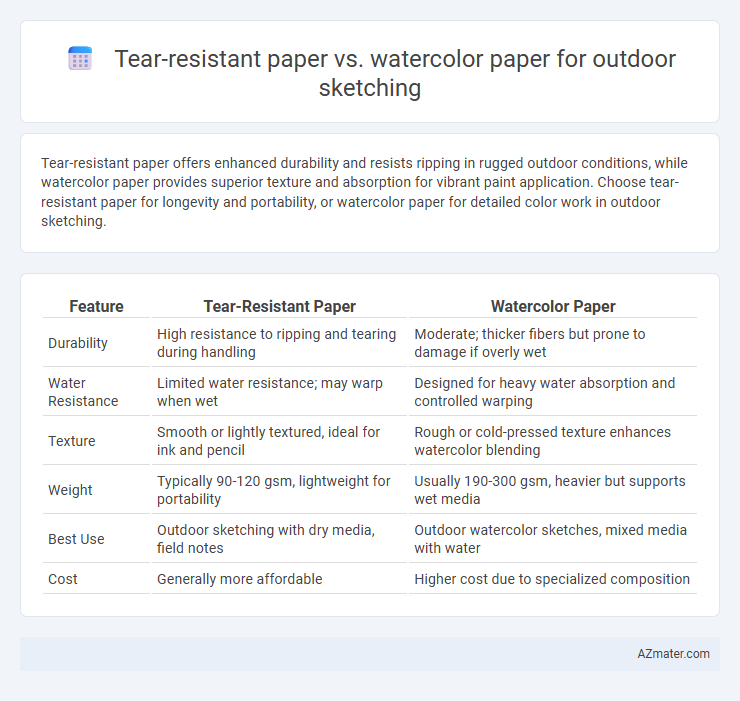Tear-resistant paper offers enhanced durability and resists ripping in rugged outdoor conditions, while watercolor paper provides superior texture and absorption for vibrant paint application. Choose tear-resistant paper for longevity and portability, or watercolor paper for detailed color work in outdoor sketching.
Table of Comparison
| Feature | Tear-Resistant Paper | Watercolor Paper |
|---|---|---|
| Durability | High resistance to ripping and tearing during handling | Moderate; thicker fibers but prone to damage if overly wet |
| Water Resistance | Limited water resistance; may warp when wet | Designed for heavy water absorption and controlled warping |
| Texture | Smooth or lightly textured, ideal for ink and pencil | Rough or cold-pressed texture enhances watercolor blending |
| Weight | Typically 90-120 gsm, lightweight for portability | Usually 190-300 gsm, heavier but supports wet media |
| Best Use | Outdoor sketching with dry media, field notes | Outdoor watercolor sketches, mixed media with water |
| Cost | Generally more affordable | Higher cost due to specialized composition |
Introduction to Outdoor Sketching Paper Choices
Outdoor sketching demands durable materials, making tear-resistant paper a popular choice due to its high tensile strength and resilience against rough handling. Watercolor paper, often made from 100% cotton with a textured surface, excels in absorbing washes and maintaining color vibrancy during wet media application. Selecting between tear-resistant and watercolor paper depends on the artist's preferred medium and the environmental conditions encountered during outdoor sessions.
What is Tear-Resistant Paper?
Tear-resistant paper is engineered with reinforced fibers or synthetic additives that enhance its durability, making it ideal for outdoor sketching where rough handling or environmental stress is common. Unlike traditional watercolor paper, tear-resistant paper resists punctures and rips, ensuring longevity even in humid or wet conditions. Its robust construction provides a reliable surface for various media without compromising structural integrity during fieldwork.
Key Features of Watercolor Paper
Watercolor paper is specifically engineered with high absorbency and a textured surface to hold water and pigment without warping or tearing, making it ideal for outdoor sketching under varying weather conditions. Its heavyweight composition, often 140 lb (300 gsm) or more, provides durability and stability when exposed to moisture compared to tear-resistant paper, which prioritizes strength but lacks optimal water handling. The archival quality and acid-free nature of watercolor paper ensure long-lasting sketches and vibrant color retention in outdoor environments.
Durability in Outdoor Conditions
Tear-resistant paper offers enhanced durability against physical damage, making it highly suitable for outdoor sketching where rough surfaces and wind can cause paper to rip easily. Watercolor paper, especially cold-pressed or heavy-weight varieties, provides excellent resistance to moisture and warping, ensuring longevity during exposure to rain or humidity. Combining tear-resistant qualities with the robust texture of watercolor paper yields optimal performance for artists working in unpredictable outdoor environments.
Handling Wet Media: Performance Comparison
Tear-resistant paper offers enhanced durability and resists ripping when wet, making it suitable for rough outdoor conditions, but it may not absorb watercolor pigments as evenly as traditional watercolor paper. Watercolor paper, designed with specific textures and absorbent fibers, provides superior color blending and water control, ensuring vibrant results even with multiple wet layers. For outdoor sketching, watercolor paper excels in handling wet media due to its absorbency and structural integrity, while tear-resistant paper prioritizes physical toughness over optimal watercolor performance.
Portability and Weight Considerations
Tear-resistant paper offers enhanced durability ideal for rough outdoor conditions, ensuring sketches remain intact despite moisture or rough handling, while typically being lighter and more portable for ease of transport. Watercolor paper, often thicker and heavier, provides superior texture and absorbency for color washes but can increase the overall weight of sketching materials, potentially limiting portability during extended outdoor trips. Choosing between these papers depends on balancing the need for durability with the convenience of carrying lighter supplies in outdoor sketching scenarios.
Texture and Surface Suitability for Sketching
Tear-resistant paper offers a smooth, durable surface that withstands repeated erasing and layering, ideal for detailed line work in outdoor sketching. Watercolor paper features a textured, often cold-pressed surface that enhances pigment absorption and brushstroke variation, making it suitable for mixed media and expressive washes in natural settings. The choice between these papers depends on the desired texture effect and medium adaptability during outdoor artistic sessions.
Environmental Factors: Sun, Wind, and Moisture
Tear-resistant paper outperforms watercolor paper in outdoor sketching by providing enhanced durability against sun exposure, resisting degradation and maintaining color vibrancy under UV rays. Its resistance to wind-driven damage reduces the risk of fraying and tearing, crucial in unpredictable weather conditions. Moisture resistance in tear-resistant paper prevents warping and buckling, preserving the integrity of sketches during rain or high humidity, whereas traditional watercolor paper can absorb water and become compromised.
Cost and Availability
Tear-resistant paper offers a budget-friendly option for outdoor sketching, often available in most art supply stores or online at affordable prices targeting casual or beginner artists. Watercolor paper, while typically more expensive due to its specialized texture and weight designed to handle water media, is widely accessible in various grades and sizes suitable for professional and advanced outdoor artists. Availability for both paper types is generally high, but watercolor paper may require purchasing from specialty art shops or dedicated sections, influencing its overall cost and access for frequent outdoor sketchers.
Which Paper is Best for Your Outdoor Art?
Tear-resistant paper offers durability and resilience, making it ideal for rugged outdoor sketching where rough handling and environmental stress are common. Watercolor paper, with its thick texture and high absorbency, excels for artists using wet mediums such as watercolors or inks, allowing vibrant color blending and minimal warping. Choosing the best paper depends on your medium and working conditions: tear-resistant paper suits dry sketching and mixed media in challenging environments, while watercolor paper is optimal for fluid, color-rich outdoor artwork.

Infographic: Tear-resistant paper vs Watercolor paper for Outdoor sketching
 azmater.com
azmater.com